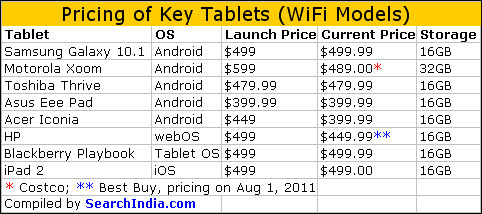To digital media aficionados, a group that includes yours truly, one of the most anticipated events is the upcoming launch of Amazon’s tablets.
Let’s make it the supposed launch since Amazon has yet to officially announce its tablet strategy.
But the rumors are flying fast and furious.
Amazon will launch three tablets. No, there will be just one. It will be a Nook-competitor and not a full-fledged tablet. It’ll be a low-priced tablet. It will be a 9-inch tablet. And so on go the rumors.
While there’s little agreement on the details, almost all writers are unanimous that Amazon’s tablet, in whatever form factor or features it may come with, will be based on the Android OS and debut in the not too distant future.
Perhaps, as early as the current quarter.
But will yet another Android tablet make any difference to the platform’s flagging status in the tablet marketplace?
It’s no secret that the Android-based tablets have so far been laggards and not made much of an impact in the tablet arena dominated by the Apple iPad, which is now in its second generation.

Major Android tablet vendors including Acer, Asus, Motorola and Samsung just don’t seem to have the wind behind their back.
Even as overall tablet sales are surging, Android vendors have failed to gain traction. Not surprisingly, their prices are falling and we’re starting to see $100 discounts (like from Staples recently).
All the iPad competitors (Android-based, Blackberry or webOS) are not selling in large numbers because for the most part they’re found wanting when pitted against the iPad (despite its lack of Flash support).
Apple reinvented the tablet market and continues to reap most of its rich rewards.
Four factors have contributed to Apple’s success in the tablet marketplace: a fairly decent product that works well for the most part, first-mover advantage that accrues to any player successfully opening up a new segment, a huge collection of applications dedicated to the device and the company’s strong positive brand image with consumers owing to its earlier phenomenal success with the iPod, iPhone and iTunes and AppStore.
With over 90,000 dedicated iPad applications, there’s a rich array of content for consumers who have flocked to the Apple side. After so many months, there are only a few hundred dedicated Android apps for the tablet (when Android fanboys tell you there are thousands of apps for the tablet what they mean is the apps written for the Android phones).
In its last fiscal quarter alone, Apple sold 9.25 million iPad tablets. In contrast, Motorola shipped (not sold) just 440,000 Xoom Android tablets in its fiscal second quarter and Research in Motion shipped (not sold) 500,000 Blackberry Playbooks in its fiscal first quarter (ended May 28, 2011). The other Android vendors are likely doing as badly if not worse.
So now you have a sense of the odds Amazon is up against and the enormous challenges it faces going up against the Apple behemoth.
When established consumer electronics players like Motorola and Blackberry find the going difficult will an Android tablet from Amazon, an online retailer with limited hardware experience, be able to make a dent in the Apple fortress.
Sure, Amazon has some advantages on its side unlike the other Android tablet vendors. It has a large existing customer base to tap into. Plus, it has amassed a huge pile of e-books, a growing collection of movies and TV shows and a vast hoard of music MP3s, all of which can be tightly coupled with the tablet and peddled to consumers through the company’s vaunted one-click shopping.
And there’s the Amazon AppStore and the Android tablet marketplace for whatever they’re worth.
But are these enough to propel Amazon’s tablets into consumers hands in large numbers?
Count us among the doubting thomases.
With most consumers strongly fixated on the iPad, we don’t see how Amazon can gain quick traction unless it launches an entry-level 16GB model at $200-$250, a significantly lower price point compared to Apple’s $499 price for the 16GB iPad 2.
Now the big question is whether at $200-$250, Amazon can get out a product that won’t look and work like you picked it up from the neighborhood thrift store.
It’s hard to get out a full-fledged 16GB tablet in the $200-$250 price band because the component pricing itself for a 9.7-inch tablet will likely exceed that not to mention the initial huge launch cost.
If Amazon comes out with a full-fledged tablet, it’s difficult to see how it can succeed unless it’s willing to take a big hit on the hardware in hopes of making money on the backend, i.e. by selling lots of content.
It remains to be seen if this is going to be Amazon’s strategy and if so, will it work.
Throwing the spanner in the works is the fact that a lot of Amazon customers, like us for instance, would likely have already purchased the iPad.
Alternatively, in the first phase Amazon can launch a limited tablet effort and replace its current generation of non-touch screen Kindle e-readers with a Android-based touch screen device.
In any case, Amazon has little choice but to enhance the Kindle soon if it wants to nip the rising challenge from the Barnes & Noble Nook touchscreen e-reader selling for $140. With the iPad also doubling as an e-reader (including for Kindle books), the writing could be on the wall for the Kindle reader as well.
Amazon may have already erred by not launching a touchscreen Kindle reader sooner.
It’s hard for us see great momentum for the current generation of Kindle. Since Amazon does not release data on Kindle, we can only hypothesize that Kindle reader sales have already started slumping with challenges from Barnes and Noble and the iPad.
Overall, any way you look at it, the prognosis for the Amazon Android tablets or even the Kindle don’t look that good going forward.

You must be logged in to post a comment Login